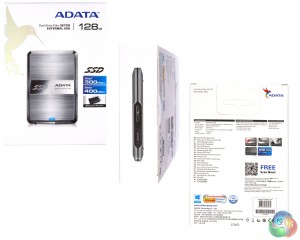
From the days of the floppy disk, the portability of data and programs has been an important aspect of computing. Today we are looking at the latest external Solid State drive from ADATA – the DashDrive Elite SE720 128GB.
When we received this device into the KitGuru Labs, one question came to mind: Is it worth trading the lower price and performance of a larger, traditional external hard drive for the much faster, more expensive, designer approach offered by an external solid state drive?
Back at the start of November 2013, we reviewed the HE720 DashDrive Elite, a 1TB product that ADATA managed to fit inside a brushed stainless steel chassis that was less than 9mm thick. At the time of going to press, the 1TB ADATA HE720 was £88 on Amazon.

The new Solid State version (SE720) offers 128GB of storage, in almost exactly the same chassis.
The SE720 is lighter, 160 grams vs 259 grams against the HE720. Packed in a bag or sitting on a desk you will never notice the additional weight, but if you plan to tuck your data device into your shirt pocket, then the solid state flash version will deliver less strain on your stitching.
Here are the basic technical specifications:-

The box is attractive and has obviously been designed for the retail space, although nothing really sets it apart from the other packing you will find in high street/airport electronics stores.
Opening up the packaging, you will find the SE720 drive itself, a leatherette carry case, instructions and the high speed data cable.
Alongside the blue operating light and data port, the SE720 has a ‘Back UP' button, to make it easy for you to grab important data from a device.
While the material is stainless steel, we found that it didn't stay stainless for long. The surface is like a paw-print magnet and we needed to give it a thorough wipe during photography or the marks stood out a mile. Maybe ADATA should have included a pair of Snooker referee gloves?
Installation was simply a case of plugging in and letting the device be recognised by the latest version of Windows on a high performance system. In this case, we have an Intel Core i7 4770k with a modest overclock and a Nvidia GTX780.

The SE720 itself is controlled by the LSI SandForce SF-2281 which you can find in many products, such as the ADATA SX910 that KitGuru reviewed back in 2012.
After completing our ATTO and CrystalDiskMark testing using the rear ports, we also ran the same tests using the ‘customer facing' USB 3 ports at the top of the fascia and we got pretty much exactly the same results. Nice to know that all ports work well in a storm of data transfers.
Already on the drive are two files: The User Guide and the ADATA Sync program, which we installed directly from the drive (remember – always check for updates to pre-installed software).
In regular use, operation of the software is simple enough. When you press the backup button on the device, it will execute preconfigured tasks, or you can execute them manually. You can configure the button to ‘back up photos on your laptop', but ‘back up everything in the My Documents folder on my desktop PC' etc.
Once set-up this is as easy as plugging in the device and pressing the button.
The ADATA SE720 also supports HDDtoGO, which allows you to browse the internet using Internet Explorer or Mozilla Firefox without leaving a trace on the computer as it is effectively self-contained on the External Hard Drive. You can also lock the computer when the device is removed and only unlock after a certain time period or when the device is plugged back in.
Now for the all important numbers.
ADATA claims a peak of 400MB/sec read and 300MB/sec write, which is very fast for an external device costing less than £100, but how accurate is that claim?
First up, we check the default CrystalDiskMark scores:-
The scores are certainly impressive – and a mile ahead of those posted by the SE720's mechanical cousin back in November. ADATA's HE720 1TB peaked around the 100MB/sec mark (+/-10MB), hitting a peak read of ~112 and a peak write speed of ~89.
In general terms, using this test, we can say that the Solid State technology in the ADATA SE720 gives it a serious advantage over mechanical drives, but the pure write speed is not as high as we would have expected. The numbers on ADATA's packaging claim a 300MB/sec write and 400MB/sec read, although we tested with the default ‘incompressible' data settings.
Let's see what happens when we put the drive through its paces with ATTO. The ATTO Disk Benchmark performance measurement tool is compatible with Microsoft Windows. It allows you to measure your storage systems performance with various transfer sizes and test lengths for reads and writes.
The results shown by ATTO are fast and we can see how dealing with compressible data can help improve the overall benchmarking scores.
Interestingly, the ATTO write speed is over 100MB/sec faster than the number claimed by ADATA. One thing we know for sure is that if a technology company can claim a larger performance number, they will do. So why wouldn't they say ‘Over 400MB/sec Write Speed'?
Again, we tried this on various systems – including a Xeon Workstation – and had a similar result in each case.
We went back and tried a different version of CrystalDiskMark and this time we tested with both default ‘incompressible data' (top image) and 0x00 ‘compressible data' (bottom image) patterns. This allowed the clever electronics inside the SE720 to process/compress data in the same way as the ATTO test and we got a similar patterns to the results.
Fascinated by the differences, we approached ADATA for an official explanation and this was their reply:-
The ADATA DashDrive Elite SE720 128GB external SSD is certainly a competent product, although we wish they would use compact naming conventions across their portfolio. In a world dominated by products like the iMac, iPhone and S4, this retail-targeted product needs to be called an SE720 and no more.
From packaging to your initial contact with the drive itself, it has an attractive look and feel, although the ironically named stainless steel enclosure stains remarkably quickly – so perhaps aluminium/magnesium/rubber would be a better choice for an upcoming revision.
In terms of performance it is easily faster than traditional, external mechanical drives. Sure, it's way slower than an internal SSD connected directly to the SATA ports, but it leaves mechanical drive options (internal or external) in the dust.
That said, we need to keep in mind the usage model for this kind of product.
Sure, it can be used with ‘Windows To Go‘ (which is part of 8.1 Enterprise), to allow you to boot to your own desktop (complete with data and apps) almost anywhere. As such, it is a glimpse into a much more mobile future for workers.
Looking at its size (physical and data), performance and pricing (around £100 in the UK), it seems to be a perfect choice for people with jobs that require a dash of style and huge data transfers. A good example would be a video editor who needs to regularly travel to a client with project updates etc.
Lastly, if you're the kind of person that wants to work at A and B, but not necessarily between A and B, then this is a great way to carry around your full desktop PC, but you would need the right set-up at home and work for it to function correctly.
Taking all of those things into account, Pros and Cons, it is not a ‘Must Have' for everyone, but it is certainly ‘Worth Buying' if you need fast access to large amounts of data – without weighing yourself down with mechanical drives.
Expected to retail in the UK for £99, it is pretty good value. We did a quick check around high street stores and found a 128GB PNY USB pen drive in Staples for £99, but that only offers 15MB/sec write and 25MB/sec read.
Pros
- Looks good straight out of the box
- Easy to install and get up and running
- Very fast data transfer for an external device
- One Touch back-up system
Cons
- Chassis marks easily
- 128GB is not going to back up an entire system
KitGuru says: Perfect drive for fast moving media types, but if you need a full backup solution then it will be too small.
 KitGuru KitGuru.net – Tech News | Hardware News | Hardware Reviews | IOS | Mobile | Gaming | Graphics Cards
KitGuru KitGuru.net – Tech News | Hardware News | Hardware Reviews | IOS | Mobile | Gaming | Graphics Cards












Good review thanks
Hello there, Is it possible to take away the enclosure and use it as an internal SSD ? 🙂